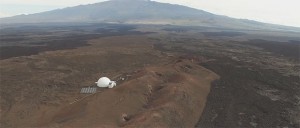How will we help our future astronauts prepare for the rigors and tribulations of exploring Mars? By starting with an eight-month stay in a well-isolated dome atop Mauna Loa on in Hawaii.
Here, a NASA analog mission will study human behavior and performance in the isolated and confined conditions of the mission, similar to that which humans will experience on a future Mars mission.
2015 HI-SEAS habitat. Image credit: University of Hawai’i News
Last week, a crew of six stepped into the habitat where they will spend two-thirds of a year. The mission is known as HI-SEAS, or Hawai’i Space Exploration Analog and Simulation. Funded by NASA, the mission aims to help figure out the individual and team requirements for long-duration space exploration missions.
Human deep space missions present many hazards, one of which is isolation and confinement that will be examined by this HI-SEAS. Gravity fields, hostile/closed environments, space radiation, and distance from Earth also present challenges that other NASA analog missions are helping to address. HI-RISE is additionally testing the hazard of distance from Earth by employing a 20 minute communication delay and partial self-sufficiency.
What else does the mission entail?
HI-SEAS involves exploration tasks that include geological fieldwork and life systems management. It includes food preparation solely from shelf-stable ingredients, exercise and research. HI-RISE will also conduct fieldwork in alignment with NASA’s expectations for planetary exploration.
The crew is comprised of four men and two women who will be part of eleven research studies. Eight of these are primary research studies and are funded by NASA.
Scientists from the U.S. and Europe will be conducting primary research. Three opportunistic studies will be conducted as well. The research team will be monitoring the crew, who will be supported by experienced mission control.
For the primary behavioral research, what will be involved? A social behavioral task will be shared for team building and sociometric badges will be used to continually observe interactions that take place face-to-face. A virtual reality exercise will be utilized to predict individual and behavioral health of the team. Multiple stress, cognitive countermeasure and monitoring studies will also be included.
Located in Hawaii, this analog mission is not only Mars-like, but allows for high-accuracy analog tasks to be carried out.
The HI-SEAS mission that began on January 19, 2017 is Mission V. The previous year-long mission, Mission IV, was extremely successful and completed this past August. By studying psychological and psychosocial factors, teams that are highly effective during long-duration exploration missions can be characterized.
In preparation for missions into deep space, analog missions help NASA evaluate the hazards of deep space exploration targets, including Mars. Before humans step foot on the red planet, understanding and being prepared for the hazards they will face is an essential component in ensuring their future mission success.
Learn more about the Mission V crew here.
Learn more about the mission at HI-SEAS.org.


